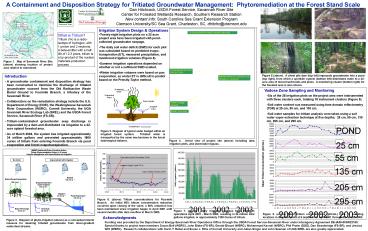POND PowerPoint PPT Presentation
1 / 1
Title: POND
1
A Containment and Disposition Strategy for
Tritiated Groundwater Management
Phytoremediation at the Forest Stand Scale
Dan Hitchcock, USDA Forest Service, Savannah
River Site Center for Forested Wetlands Research,
Southern Research Station New contant info South
Carolina Sea Grant Extension Program Clemson
University/SC Sea Grant, Charleston, SC,
dhitchc_at_clemson.edu
Irrigation System Design Operations
- Twenty-eight irrigation plots on a 22-acre
project area have been irrigated with
pond-collected groundwater seepage. - The daily soil water deficit (SWD) for each plot
was calculated based on predicted evapo-
transpiration (ET), measured precipitation, and
monitored irrigation volumes (Figure 4). - Summer irrigation operations depended on whether
or not a sufficient SWD existed. - Winter irrigation volumes were based on pan
evaporation, as winter ET is difficult to predict
based on the Priestly-Taylor method.
What is Tritium? Tritium (3H) is a radio- isotope
of hydrogen, with 1 proton and 2 neutrons. A
beta-emitter with a half-life of 12.3 years,
tritium is a by-product of the nuclear materials
production process.
Introduction
Figure 5 (above). A sheet pile dam (top left)
impounds groundwater into a pond (top right),
from which a sprinkler system (bottom left)
distributes water to a 22-acre area of mixed
hardwoods and pines. A monitoring cluster
(bottom right) for the forested area is also
shown.
- A groundwater containment and disposition
strategy has been constructed to minimize the
discharge of tritiated groundwater sourced from
the Old Radioactive Waste Burial Ground to
Fourmile Branch, a tributary of the Savannah
River. - Collaborators on the remediation strategy include
the U.S. Department of Energy (DOE), the
Westinghouse Savannah River Corporation (WSRC),
Cornell University, the UGA Savannah River
Ecology Lab (SREL) and the USDA Forest Service,
Savannah River (FS-SR). - Tritium-contaminated groundwater seep discharge
is impounded by a dam and distributed via
irrigation to a 22-acre upland forested area. - As of March 2004, the system has irrigated
approximately 34 million gallons and prevented
approximately 1800 curies of tritium from
entering Fourmile Branch via pond evaporation and
forest evapotranspiration.
SHEET PILE DAM
POND
POND
Figure 3. Diagram of typical water budget within
an irrigated forest system. Tritiated water is
transported by the same mechanisms in the forest
hydrological balance.
25 cm
25 cm
55 cm
Mean Tritium Concentration (pCi/mL)
135 cm
205 cm
295 cm
Figure 6. (above) Tritium concentrations for
Fourmile Branch. An initial 60 tritium
concentration reduction occurred upon closing of
the valve a 80 reduction has been maintained
since irrigation began in April 2001 until
several months after dam overflow in March 2003.
2001
2002
2003
2001
2002
2003
Figure 7. (above) Daily irrigation volumes from
irrigation operations April 2001 - March 2004,
resulting in 34 million total gallons irrigated,
or approximately 1200 Curies of tritium.
Figure 8. (above) Mean tritium concentrations
(pCi/mL) from 18 sampling locations in irrigation
plots at 5 depths from April 2001 through
December 2003.
Figure 2. Diagram of phyto-irrigation (above) as
a conceptual interim measure for retaining
tritiated groundwater from down-gradient
watershed streams.

